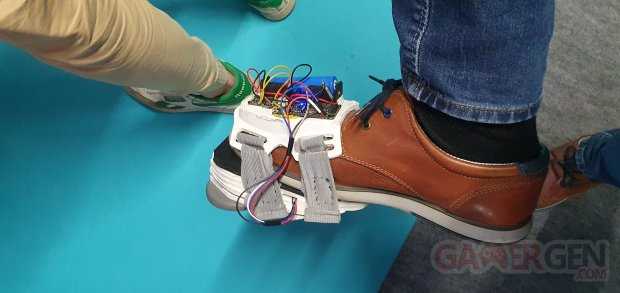Locomotion is an often tricky subject when it comes to getting around in virtual reality. To alleviate the motion sickness (nausea), various software solutions can be implemented in experiments VR such as teleportation, arm movement or trotting.
There are also different alternatives, this time material like the virtual mats, like theOmni of Virtuixfrom VR Shoesto walk naturally while standing on the spot, or 3dRudder to move this time while sitting. The most of these solutions tend to improve the experience VR in order to make our movements more natural, more realistic than with the joysticks that our controllers have.
It is in this sense that the project Sabo, worn by Robin Exbrayat, a student at the Nantes Atlantique design school, is interesting. Met at the show Laval Virtualhe made us test his prototype of connected shoe allowing to get rid of the controllers to move.
Sabo aims to improve the user experience in virtual reality.
For this, I transferred the management of movements, initially carried out by the hands, to that of the feet in order to be as close as possible to reality. Being relieved of this constraint, the use becomes more intuitive, thus offering the possibility of developing new tools dedicated to the hands. – Robin Exbrayat
We were able to hold the famous prototype in our hands, but also put it on one of our feet. We will not take into account the design of the product in its development phase, because as its creator told us, the assembly is very basic. On the stand, however, we could see displayed what could be similar to the product as it will be once finished with a sexier look and a form-factor more reduced.
For the rest, the Sabo works as follows: a joystick is embedded in a sole placed on a plate. Everything is mobile so that our foot, once put on, can move in all directions.. The shoe is equipped with a wireless device coupled to Meta Questpresented during the demo, which is recognized as a full-fledged controller.
Sabo offers three types of interactions:
- Choose a direction;
- Move forward, backward and sideways;
- Trigger an action like a jump or open a menu.
So much for the theory. We were able to try out this new mode of locomotion and the result is convincing. The creator tells us all the same thatan adaptation phase is necessary so that we adapt to this new controller while striving to no longer touch the joysticks with the thumbs. After the first galleys, it becomes pleasant to delegate our movements on one of our feet. We indeed feel this new freedom in the hands. We can move forward while turning our heads in a more natural way and boasting that we only use the controllers to interact with the environment. However, to perform a U-turn, it is necessary to turn around yourself. The demo presented on the show had us move from point A to point B in a fantasy-like forest, while dodging the creatures in our path.
Rather successful and convincing trial, however, requiring a real learning curve to take full advantage of it and realize its potential, which is not always the case at shows. The product will have time to evolve and be refined, and who knows, we may find it soon for purchase. In any case, that’s all we wish for Robin.
The concept of Sabo brought a certain comfort for people with only small play spaces and wanting to move in a slightly more natural way. This project may also benefit people with disabilities wishing to move in virtual reality in experiences focused on exploration, but not being able to fully utilize the upper body and therefore the controllers.
If you haven’t taken the plunge yet, you can treat yourself to a Oculus Quest 2 at the house of Bakerthe Fnac, Darty or Amazon for €349.99. You can also find good PCs for gamers there.
